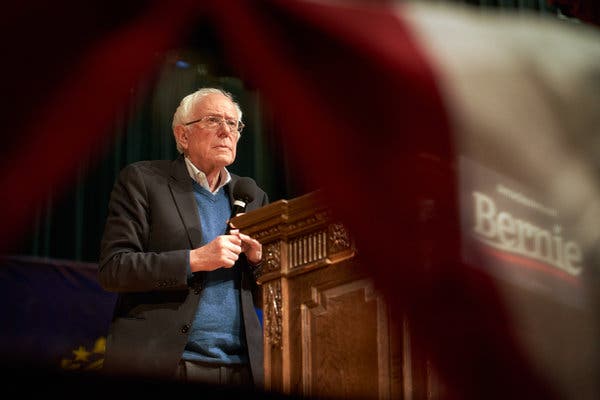Morgan Harper is challenging Representative Joyce Beatty in a solid blue Ohio district, the latest front in the Democratic clash between left and far left.

COLUMBUS, Ohio — As Morgan Harper campaigned at the Prestige Cuts & Styles barbershop here, Joe Copeland, a retired school principal, said he had never heard of the young woman mounting an insurgent primary challenge of a Democratic member of Congress. But he thought of a comparison.
“Is this the same type of situation as with A.O.C.?” he asked.
Indeed, there are similarities between Ms. Harper, 36, and Representative Alexandria Ocasio-Cortez of New York, whose felling of a powerful House incumbent in 2018 was a shock alert to national Democrats of a populist wave.
Ms. Harper announced this past week that in just three months as a first-time candidate, she had raised an impressive $323,000, riding the endorsement of Justice Democrats, the same anti-establishment progressive group that backed Ms. Ocasio-Cortez.
Ms. Harper is running against Representative Joyce Beatty, 69, who is in her fourth term representing Ohio’s Third District. Campaigning for a guaranteed income, reparations for African-Americans and other policies designed to end “economic segregation,” Ms. Harper, a former senior adviser at the Consumer Financial Protection Bureau, sees no need to spend years ascending the rungs of local politics. “The world is on fire and we need a lot to get done,” she told Mr. Copeland in the barbershop.
The dynamic in this Ohio congressional race — which is being echoed in House races across the country where grass-roots progressives have declared civil war on establishment Democrats — will be on display in the party’s 2020 presidential debate on Tuesday night, which will take place in a Columbus suburb partly in Ms. Beatty’s district.
As Democrats wrestle over who would be their best nominee to defeat President Trump, the energy and momentum is with the progressive populism of Senators Elizabeth Warren of Massachusetts and Bernie Sanders of Vermont. But there will be several longtime Democratic officeholders onstage who are also committed to liberal policy goals like expanding health care, strengthening gun control laws and raising taxes on Wall Street and the wealthy.
Like Ms. Harper and Ms. Beatty, the Democratic presidential candidates and others in the party are now debating just how much progressive change to push for, and what’s possible to achieve.
“I think it’s hard when someone who has been registered for seven or eight months in the district says they know what the people want,” Ms. Beatty said in a jab at Ms. Harper, a Columbus native who moved back to the city in December after a career in New York and Washington.
Ms. Harper is campaigning by attending as many community events as possible, and by old-fashioned neighborhood canvassing. There are some signs her strategy is working. She said she had raised money from nearly every ZIP code in her district. (Ms. Beatty, who hasn’t reported third-quarter fund-raising, had $1.3 million cash on hand as of July.)
Ms. Harper has focused on residents left out of the recent growth of Columbus — now Ohio’s most dynamic city, surpassing Cleveland — and the gentrification that has followed.
A wave of new apartment blocks, craft breweries and espresso shops radiating from downtown has pushed out poor residents, many of them black. Ms. Harper’s website calls Columbus the second most economically segregated city in the country.
In the barbershop, Mr. Copeland, the retired principal, said he was a personal friend of Ms. Beatty from “way back,” but that wouldn’t cement his vote.
“We’re in a bad state of affairs,” he said, referring to local and national events. “When we’re looking at elections and who we’re going to be sending to Congress and that sort of thing, we’re probably in a position where good friends and all that kind of stuff is going to go by the wayside.”
Aaron Pickrell, a Democratic strategist in Columbus, predicted Ms. Beatty would take Ms. Harper seriously, but added that he did not see her as a vulnerable incumbent who had lost touch with voters.
“She’s exactly what you’d want from a member of Congress,” said Mr. Pickrell, who ran Barack Obama’s 2008 presidential campaign in Ohio. “She’s in her district every weekend. She has a progressive record. She advocates for people of color and low-income families and the immigrant community.”
On Wednesday, Ms. Beatty was the keynote speaker at a conference on closing the racial and gender wealth gap. Later, at a job fair for people with disabilities, Ms. Beatty worked the room as if it were a block party. She spotted Nina Miller, a job-seeker in a wheelchair, and gushed. The two had met before. Ms. Miller, 51, was looking for work at the table of a customer call center. “Let me vouch for her,” the congresswoman told the employer. “I want to be a reference.”
To Larry Cunningham, a middle-aged man who had just been hired by McDonald’s, Ms. Beatty offered a week’s worth of bus tokens from a stash in her district office. “First impressions are so important,” she told Mr. Cunningham. “On your first day, you want to get that earlier bus because everybody’s looking for the new man.”
Ms. Beatty has not faced a primary challenge since winning her seat in 2012. Before that, she was an official at Ohio State University and spent 10 years in the State House of Representatives, eventually becoming the first woman to serve as its Democratic leader.
In an interview, she took off the gloves when it came to Ms. Harper, whose résumé includes jobs at the C.F.P.B. and the corporate law firm Cravath, Swaine & Moore — but no community service or organizing in Columbus.
“I know there is no volunteer record of being in the community with health care, or children with diabetes or fighting for public education,” Ms. Beatty said of Ms. Harper. “Has she ever gone over and provided Christmas toys for children who are homeless and then worked hours feeding them?”
Ms. Beatty accused Ms. Harper of raising “false hope” by backing programs like “Medicare for all” and the Green New Deal without a plan to pay for them, and she described Ms. Harper’s platform as an off-the-shelf template developed by national groups, one built by “trust-fund babies and million-dollar folk that work on the East Coast.”
Ms. Beatty is one of 118 sponsors of a Medicare for all bill in the House, but she clarified that she believes in “Medicare for all who want it” and that the government shouldn’t force union members to give up private insurance.
Ms. Harper strongly rejected the notion that she was a Columbus outsider with outside ideas.
“My name is Morgan Harper,” she said in an interview at her campaign office. “I was born here in Columbus, Ohio, at The Ohio State University Hospital. I was given up for adoption. I lived in a foster home for nine months in this district.”
She continued to lay out her biography, a powerful part of her candidacy: Raised by a single mother, she won a scholarship to a local prep school, then attended Tufts University. She earned a master’s degree from Princeton and a law degree from Stanford.
“My policy is 100 percent informed by the people that are living here,” she said.
Later, in an email, Ms. Harper said Ms. Beatty was the one who was out of touch, calling her “a politician who has been around since 1999, whose campaigns are funded by corporations, is not from Central Ohio, is worth over $4 million” and “lives in Blacklick,” an affluent neighborhood.
She “tells her constituents (who live in the second-most economically segregated region in the country) that she’s fighting for them,” Ms. Harper said. “To me, that’s false hope.”
The intensely personal attacks from both candidates may do more harm to Ms. Harper, who is little known and still undefined to Columbus voters compared with Ms. Beatty.
“Joyce Beatty, one of the things you know about her is she does touch people,” Michael Sexton, the chairman of the Franklin County Democratic Party, said. “I would say she’s out there fighting for our district every day.”
Ms. Harper spends her days talking to residents about her platform, which also includes guaranteed jobs and national rent stabilization. “A lot of people, as soon as I start talking about these issues, they’re like, ‘Thank you, because I’ve been waiting for somebody to actually talk to me,’” she said.
On Thursday, she visited the Hilltop neighborhood on the city’s West Side, walking along an avenue of houses in disrepair, tattoo parlors and Family Dollar stores. Stopping for a soft-serve cone, she introduced herself to two young men at a table.
“I’m backing a thing called the Green New Deal,” Ms. Harper told them animatedly. “Have you ever heard about that?” The men shook their heads.
Farther along the avenue, she ran into Esther Flores, a community activist she knew. Ms. Flores was on her way to a drop-in center she runs that offers meals and clothing to sex workers and victims of human trafficking.
“You need to come and talk to the girls,” Ms. Flores told Ms. Harper. “We’ve got some girls that are voters.”
Ms. Harper promised to do that.
Trip Gabriel is a national correspondent. He covered the past two presidential campaigns and has served as the Mid-Atlantic bureau chief and a national education reporter. He formerly edited the Styles sections. He joined The Times in 1994. @tripgabriel • Facebook


